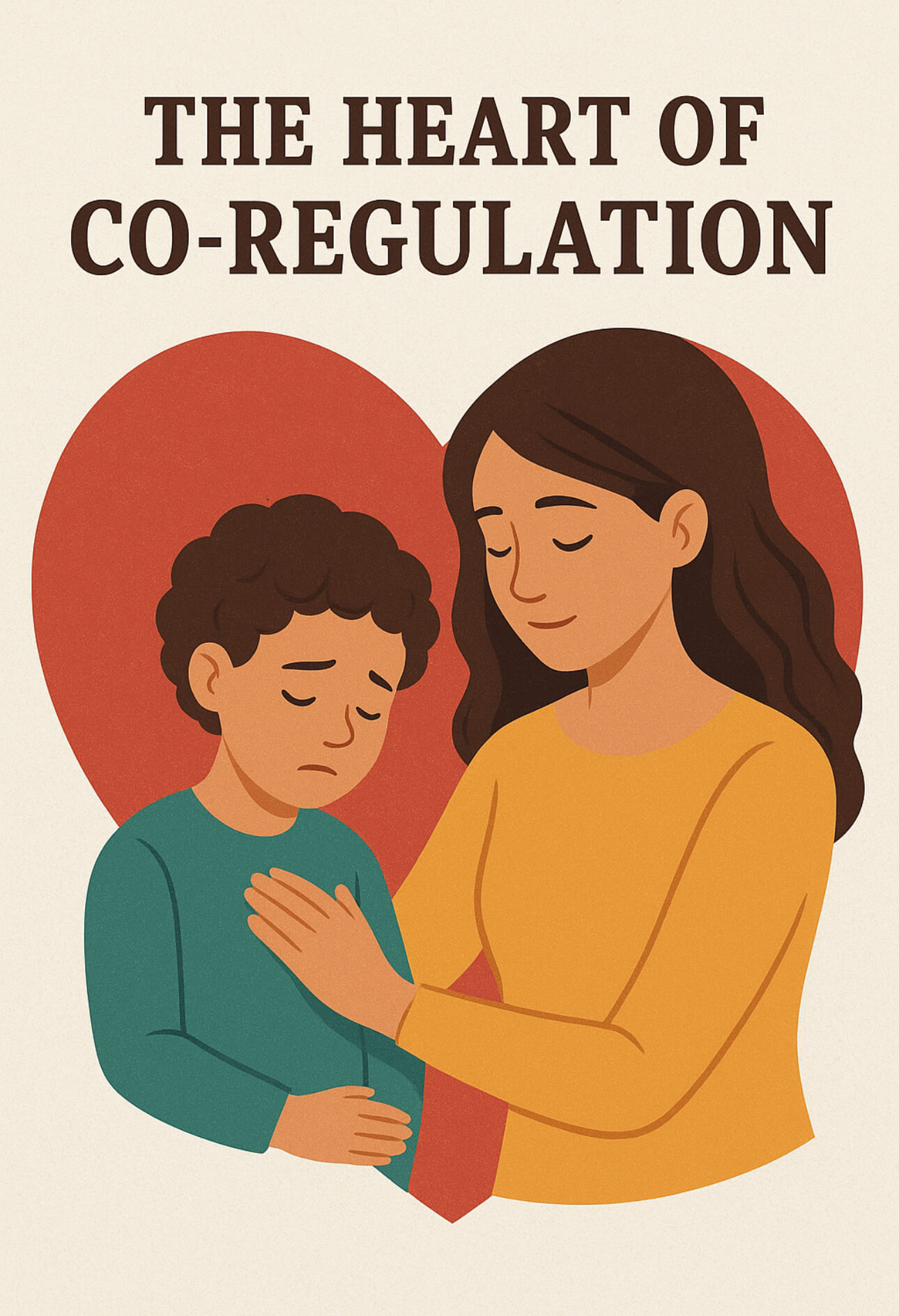The holidays can bring moments of magic — sparkling lights, familiar songs, cozy family gatherings. But for many parents and caregivers, they also bring full schedules, high expectations, sensory overload, and an endless to-do list. The season that’s meant to bring connection can easily leave our nervous systems on overdrive.
As parents and caregivers, we often focus on supporting our children through holiday stress: keeping routines somewhat consistent, preparing them for transitions, and helping them manage the emotional ups and downs of change. Yet we sometimes forget that our own regulation forms the foundation for how our children experience the season. When we feel grounded, calm, and connected to ourselves, we can co-regulate with them, providing a sense of safety that helps them settle more easily into the moment.
So what does regulation really mean? Regulation is our body’s ability to return to a place of neutrality after stress or stimulation. It’s not about staying calm all the time — it’s about noticing what’s happening inside us and finding ways to come back to center or a neutral state. In somatic work, regulation begins in the body, not the mind. The body leads the way through breath, movement, touch, and sensory experiences that signal safety to the nervous system.
Regulation starts with awareness — noticing subtle cues from our body before we reach the point of overwhelm. A racing heartbeat, shallow breath, or tightness in your body are invitations to slow down and reconnect. These small moments of noticing become portals back to neutrality and self-trust, allowing us to meet the season with more ease and authenticity.
Many of us know common suggestions for regulation — taking deep breaths, going for a walk, or carving out alone time. These can help, but sometimes our nervous system craves something more embodied, creative, or playful — something that brings us fully back to life rather than just calm.
Below are 10 somatic tools for parents and caregivers to stay grounded through the holidays. These ideas invite presence, curiosity, and connection amid the holiday chaos.
10 Somatic Tools to Support Holiday Regulation
- Self-hug
Wrap your arms around yourself, squeeze gently, and breathe. This simple act activates the body’s calming response and helps you feel safe in your own skin. - Dance it out
Put on your favorite song and move however your body wants. Movement releases built-up tension and reconnects you with yourself. - Water immersion
Step into a bath, shower, or even wash your hands slowly in warm water. Water helps reset the senses and invites a full-body exhale. - Holiday scent pause
Smell can be deeply regulating. Use a seasonal scent — cinnamon, orange, or pine — and take a slow inhale to ground yourself in the present moment. - Expressive scribbles
Grab a pen and paper and scribble out your stress. It doesn’t have to look like anything — the act of movement and expression helps emotions flow. - Micro-movement breaks
Jump, shake, stretch, or sway — short bursts of movement keep your energy from stagnating and help the body process stress. - Stress “externalization”
Give your tension a fun name, like your Tension Troll, and imagine sending it away with a flick of your hand. Playfulness helps release stress and invites humor into hard moments. - Ritual object
Keep a small item — a bell, ornament, or stone — that you touch or hold when you need to pause and breathe. Rituals create a sense of stability amid busyness. - Partnered touch or intimate connection
Share a mindful hug, gentle massage, or hand-hold with your partner. Physical connection co-regulates the nervous system and strengthens intimacy. - Solo intimate self-care
Take a few mindful moments to connect with your own body — through gentle touch, stretching, or self-massage. Tuning into your body helps release tension and restore energy.
The holidays can pull us in many directions — toward family obligations, traditions, and expectations. Yet true presence with our loved ones comes from within our own regulated body. When we tend to our inner world, we show up more available, patient, and connected — not just for our children, but for ourselves.
Staying rooted in connection means allowing ourselves to feel, to pause, and to return to our neutral state again and again. In the noise and activity of the season, these small moments of regulation are acts of deep love — quiet reminders that we deserve the same care and attunement we so readily offer to others.

Tovah Petra, MA, is a Somatic Practitioner and the creator of the Whole Family, Whole Child approach, where she helps parents of neurodivergent kids create emotionally safe, attuned, and connected homes — while also nurturing their own nervous systems, relationships, and intimate connection. Learn more at: www.tovahpetra.com
October brings with it the crisp air of autumn, pumpkins on doorsteps, and a season of playful scares. Halloween may be about jump-scares and haunted houses, but for many expecting parents, the unknowns of birth can feel far more intimidating than any ghost story. Birth is often portrayed as unpredictable and overwhelming, leaving many people feeling more afraid than excited. Yet it doesn’t have to be this way. By using somatic practices—body-based approaches that ground us in the present—we can prepare for birth with calm, trust, and even joy.
Fear is a normal part of anticipating birth. The body and mind instinctively tense when faced with uncertainty. Questions about pain, safety, or how the experience will unfold can quickly spiral into anxiety. When the nervous system is activated in this way, the body may resist rather than open. Birth, however, requires softening and flow. This is where somatic tools become invaluable. They help us regulate the nervous system, release tension, and connect to the innate wisdom of our bodies. Instead of getting caught in the question, “Why am I feeling this?” somatic practices invite us to shift toward, “What is my body feeling right now?” That small change helps us step out of mental narratives and into direct sensation, where grounding and safety can be found.
During my own pregnancies, I discovered the power of somatic preparation. I gave birth to both of my children at home, and while I felt deeply aligned with that choice, it didn’t mean I was free from fear. My first birth had been frightening, and when I became pregnant again, I knew I needed a different approach. One of the most powerful tools I used was visualization. I asked someone with a calm, comforting voice to record a guided track for me, and I listened to it every single day leading up to labor. In those moments, I could imagine my body softening and opening, my baby descending gently, and the space around me filled with warmth and calm. Listening daily gave my body a rehearsal, a way to know what trust and safety could feel like. This practice isn’t limited to homebirth. Whether you are preparing for a hospital birth, a birth center, or home, using a guided track or creating your own visualization can make the unfamiliar feel more familiar and accessible.
Grounding through the senses was another key practice. During labor, I intentionally noticed small, tangible details: the coolness of the floor under my feet, the sound of my breath, the steady rhythm of my partner’s hand on my back. These anchors kept me present in my body rather than swept away by fear. For someone birthing in a hospital, grounding might come through noticing the softness of a blanket, the steady rise and fall of your breath, or the reassuring presence of a loved one nearby. The practice is less about the environment itself and more about finding orientation and peace in the present moment.
Water was another powerful ally for me. Standing under the shower or sinking into a warm bath created an immediate shift in my nervous system. The sensation of water flowing over my skin brought relief, release, and a sense of ease. For those who use a birth pool, water can create a cocoon-like environment that feels both soothing and protective. Even outside of labor, water can serve as a reset—washing away tension and reminding the body to flow instead of resist.
Breathwork was perhaps the simplest yet most powerful tool. Our breath is the bridge between body and mind. Slow, steady breathing helped regulate my nervous system and provided a rhythm to follow through each wave of contraction. I often paired my breath with visualization, exhaling as if I was releasing tension and inhaling as though drawing in strength. Breathwork transcends birth settings—it is available to every parent, in every circumstance.
What surprised me most was how these somatic tools extended beyond the birth itself. Bringing a baby home, whether from the hospital or into your own living room, can feel like stepping into another kind of unknown. The sleepless nights, constant feedings, and the overstimulation of a newborn adjusting to life outside the womb can feel overwhelming. The same grounding practices that carried me through birth also helped me stay steady during those early days. When I felt stretched thin, I would take a moment to orient my senses, breathe deeply, or step into a warm shower to remind my body that we were safe.
In some ways, a newborn experiences the world much like we experience Halloween—loud, unpredictable, and filled with strange sensations. Parents who can stay grounded offer a nervous system anchor for their child. By tending to our own regulation, we create an environment where our babies can feel secure, even in the midst of chaos.
Birth preparation does not have to be about eliminating fear. Instead, it can be about transforming fear into trust. By practicing visualization, grounding, water immersion, and breathwork, we give ourselves tools that support not only labor but also the tender weeks that follow.
My homebirths gave me firsthand experience of how powerful these practices can be, but they are not limited to one type of birth. They belong to all parents, in every setting, who long to meet birth with presence, strength, and openness. Birth may always carry an element of the unknown, but it doesn’t have to feel like a haunted house. With the right tools, we can walk into it not trembling, but rooted in the wisdom of our bodies and the assurance that we are capable of moving beyond fear into trust and faith.

Tovah Petra, MA, is a trauma-informed somatic practitioner and creator of the Whole Family, Whole Child approach. She helps parents of neurodivergent children create emotionally safe, attuned, and connected homes—while nurturing their own nervous systems, relationships, and intimate connection. Learn more at: www.tovahpetra.com
In my early 20s, I found myself fascinated and deeply curious about autism while working hands-on at a special place called Education Spectrum in Altadena, CA. I didn’t know why I felt so drawn, but I followed that inner pull. That curiosity became my Master’s thesis in 2007, titled Autism: An Extraordinary Opportunity in Education, where I wrote about autism through the lens of a whole child approach.
At the time, I didn’t fully understand why my heart was so invested. I just knew it mattered. Fast forward to 2025—eighteen years later—and I find myself building something that reflects the very seeds I planted back then.
While searching through bins in storage recently, I came across a hard copy of my thesis. Reading those pages brought me to tears. So much of what I dreamed about and wrote then, I am now living and creating. Not word for word, but the essence—the vision— is similar.
Today, I offer services as a trauma-informed somatic practitioner, supporting children on the autism spectrum and their families through a whole child, whole family approach. My work is about more than strategies or behaviors—it is about connection, regulation, and resilience, through somatic approaches that support the body, helping children and families feel safe and regulated. I remain deeply committed to continuing to advocate for these children and their families, ensuring they are seen and supported.
Back then, I could not have imagined the path I would walk. I have spent these years raising and homeschooling my two children, and through that, learning more than any textbook could have taught me. With the addition of my two-year Somatica training, a trauma-informed somatic-based program, I am now stepping more fully into this work, and it feels both brand new and divinely familiar.
There is a reason God has guided me back to this place. I feel it in my bones. The years in between were not wasted—they were preparation. They were life shaping me, training me, humbling me, and reminding me what really matters.
I never would have guessed I would return to this work after so many seasons passed, but now I can see the thread... I was always being guided here.
With gratitude for this journey and for the children and families I have the honor of supporting,
Tovah Petra
Tovah Petra

We are at a turning point in how we care for children—especially neurodivergent ones. For too long, developmental support has relied on behavior management, compliance, and control. But what if the real transformation begins with connection?
Instead of asking, “How do I get this child to behave?” we could ask, “How can I help this child feel safe enough to thrive?”
In my work with neurodivergent children—in homes, schools, and community settings—I have seen that what they need most is relational safety. They long to be met by someone who can hold their emotions, understand the nuances of their communication, and accept them fully—without rushing to fix, shut down, or shame them. Equally important is giving them the space and support to regulate their own nervous systems, so they can build lasting skills to feel grounded from within.
Why Regulation Comes First
When a child is dysregulated—overwhelmed or shut down—they cannot learn or engage. Their nervous system is doing what it was designed to do: protect. In that protective state—fight, flight, freeze, or fawn—they cannot access logic, language, or connection.
Many behaviors we label as “problematic” are actually nervous system responses. When we regulate ourselves first, we invite children into co-regulation. Emotional safety is built not through demanding calm, but through embodying calm. Not through punishment, but through presence.
A key part of this approach is attuning to subtle cues—tiny shifts in posture, gaze, or facial expression—and responding in a way that meets the child where they are. Regulation is not about compliance; it is about creating a relationship in which the child feels reliably safe.
Relational Engagement Is Everyone’s Job
One of the most powerful shifts we can make is to stop thinking of emotional development as a job only for specialists. Teachers, paraeducators, occupational therapists, counselors, and parents all play a role in a child’s relational ecosystem.
The tone you use.
The way you respond to dysregulation.
The presence or absence of empathy in a challenging moment.
All of it shapes a child’s nervous system, self-worth, and capacity for trust. When all adults recognize their role in co-regulation, we create a culture where no one says, “That’s not my job” when a child is struggling. We come closer. We listen with our whole bodies. We hold space for the child—and each other.
Practical Ways to Bring Co-Regulation Into Daily Life
Co-regulation can be woven into everyday moments. Attuning to a child’s nervous system and responding with empathy allows them to feel seen, understood, and safe:
• Start with your own regulation. Take a slow breath before responding. Children feel our nervous system state more than they hear our words.
• Observe micro-signals. Notice subtle shifts in posture, gaze, or expression as cues to their emotional state.
• Lower your voice, not your boundaries. Calm, steady tones bring a child back into safety while maintaining limits.
• Offer a regulating anchor. Gentle touch, rhythmic movement, or simply sitting nearby invites reconnection.
• Name what you notice. “I see your hands are tight and your face is frowning. I am here with you.” Naming without judgment helps a child feel seen.
• Practice during calm moments. Regulation skills build best through play, joy, and connection—not just during crises.
These are not “fix-it” tools; they are ways of showing up so safety and connection become the norm. Integrating attunement into daily routines helps children learn that the world can be predictable, safe, and supportive.
A New Standard of Care
Regulating to relate is not a checklist—it is a daily practice. It asks us to slow down, stay grounded, and offer the presence many of us needed ourselves as children. It is a radical shift, but a deeply human one.
When co-regulation and emotional attunement become shared language across homes, schools, and clinics, we step into something profound. We become not just educators, providers, or parents—we become relational stewards of the next generation.
In that shared space, we find something powerful:
A culture rooted not in control, but in connection.
And from that place, everything begins to grow.

Parenting a child with Autism Spectrum Disorder (ASD) is a profound journey of love, resilience, and devotion. It’s also one that can put tremendous strain on a couple’s intimacy. Many parents silently shoulder the stress of therapies, school meetings, and caregiving, while quietly experiencing a growing disconnect from their partner.
Research shows that parents of children with ASD face higher-than-average rates of divorce. A study found that about 23.5% of parents of children with autism divorced, compared to 13.8% of parents of neurotypical children. Another long-term study following families into adulthood found that 36% of parents of children with autism had divorced by the time their child turned 30. While the myth of an “80% divorce rate” has been debunked, the truth remains: parenting a neurodivergent child increases stress and can deeply affect a couple’s relationship.
So why is intimacy so difficult for many of these parents?
First, there’s the sheer exhaustion. Many children with autism need higher levels of support, which can mean disrupted sleep, heightened behavioral challenges, and constant advocacy in schools or healthcare settings. By the time parents have a moment together, they’re depleted.
Second, partners often slide into co-managing the household and therapies, which leaves little space for romance. Conversations become about logistics rather than longing. Couples start to feel like roommates instead of lovers.
Third, guilt plays a role. Many parents believe they should always put their child’s needs first, leaving no room to prioritize their own connection. But intimacy isn’t a luxury—it’s a lifeline. Without it, disconnection grows, stress multiplies, and resentment can build quietly over time.
And then, there’s the silence. Parents often don’t talk about how isolated, touch-starved, or lonely they feel in their relationships. Without vulnerability, intimacy withers.
The good news is that intimacy can be nurtured, even in the most stressful circumstances. Progress doesn’t come from sweeping changes overnight, but from small, consistent shifts. Here are some ways forward:
- Create micro-moments of connection. Pause to hold hands, exchange a long hug, or share eye contact. These little acts regulate the nervous system and remind you that you’re more than just co-parents.
- Talk vulnerably. Share not just your stress but your desires, longings, and fears. Bringing your full, authentic self into connection naturally deepens intimacy.
- Schedule couple time. It may feel unromantic at first, but creating protected time for closeness ensures it doesn’t get lost. Even 15 minutes a day can help rebuild intimacy.
- Seek pleasure in simple ways. Intimacy isn’t only about sex. A shared laugh, a gentle massage, showering together, or a walk can all bring the body and heart back into connection.
- Ask for support. Respite care, family help, or leaning on a community can open space for your relationship. You don’t have to do this alone.
Your intimacy matters. Not only for your relationship, but for your ability to feel grounded, resourced, and connected as a parent. When your relationship is nurtured, your whole family feels the ripple effect of safety and love.
If you’re feeling the weight of disconnection in your partnership, know that you’re not alone. I help parents create the vulnerability, safety, and connection that allows intimacy to come to life again. I’d love to connect with you.
Warmly,
Tovah Petra
Tovah Petra

Feeling ready to reconnect and bring intimacy back to life in your relationship? You can book a complimentary 15-minute consultation with me here: tovahpetra.com




